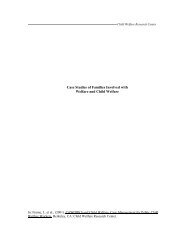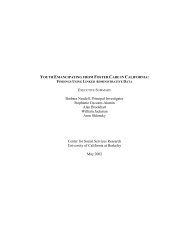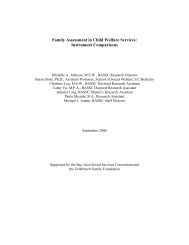Developing a Self-Assessment Toolfor Culturally - Office of Minority ...
Developing a Self-Assessment Toolfor Culturally - Office of Minority ...
Developing a Self-Assessment Toolfor Culturally - Office of Minority ...
Create successful ePaper yourself
Turn your PDF publications into a flip-book with our unique Google optimized e-Paper software.
Appendix B-2Conceptual Framework for the CLAS in MCOs StudyDOMAIN / KEY ELEMENT1. Organizational GovernanceA. Governing boards, committeesand positionsB. Organizational StructureSTUDY VARIABLESA. Board <strong>of</strong> directors subcommittee on CLASCommunity advisory committee on CLASCommittee recruitment strategiesCommittee racial/ethnic compositionCommittee diversity other than race/ethnicityInternal CLAS working groupStaff position specifically for CLAS coordinationB. Organization type – HMO, PPO, POSCorporate status – pr<strong>of</strong>it, non-pr<strong>of</strong>itModel type - IPA, group, network, staffMembership size – total enrollment2. CLAS Plans and PoliciesA. Corporate planning A. Formal QI plan for culturally and linguistically diverse membersStaff and community inputMission statement addresses CLASFrequency <strong>of</strong> committee meetingsCommittee roles related to CLASB. Corporate policies B. Policy governing written translationDescription <strong>of</strong> translation policyReasons translation policy existsReasons translation policy does not existPolicy governing interpretation servicesDescription <strong>of</strong> interpretation services policyReasons interpretation services policy existsReasons interpretation services policy does not existFormal grievance process for CLAS-related concernsInternal communication strategies for CLAS policiesFormal staff diversity planFormal diversity training program3. Patient CareA. <strong>Assessment</strong> and TreatmentB. Materials and Environment4. CLAS Quality Monitoring andImprovement (QMI)A. Tracking systemB. Needs assessment (NA) andevaluationCOSMOS Corporation, December 2003 B-5A. Cultural differences and preferences considered during treatmentCollaborate with culturally-specific healers on treatmentUtilize alternative and complementary treatmentsB. Various culturally responsive strategies implementedCharacteristics <strong>of</strong> written materialsA. Multiple methods for monitoring CLAS qualityQuality <strong>of</strong> care data collectionUses <strong>of</strong> QI dataLink member demographic and outcome dataLink member and provider dataLink member and (other) staff dataB. Routine member/community needs assessments (NA) conductedFrequency <strong>of</strong> member NATypes <strong>of</strong> community/member groups that participate in NAMember/community NA specifically for CLASData sources for member/community CLAS NAStaff NA conducted specifically for CLAS-related issuesFrequency <strong>of</strong> staff NATypes <strong>of</strong> staff who participate in NATypes <strong>of</strong> corporate support for QI and NA activities(Continued on next page)
















